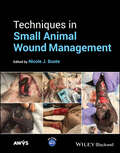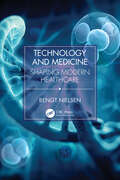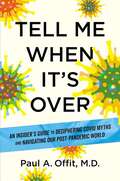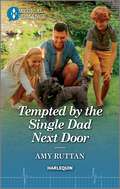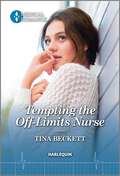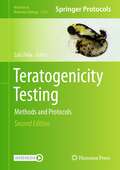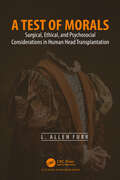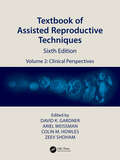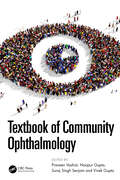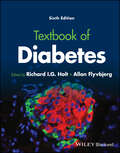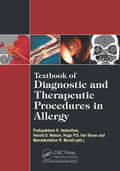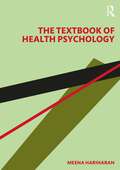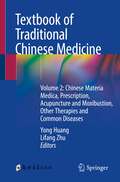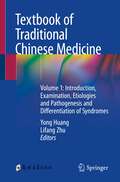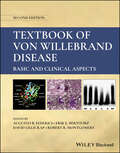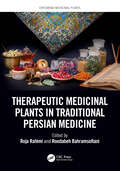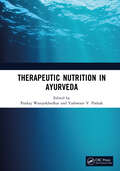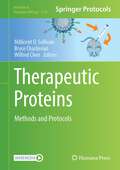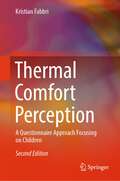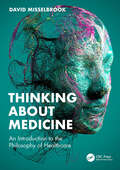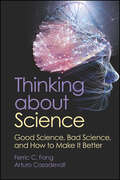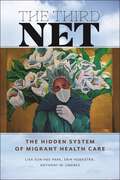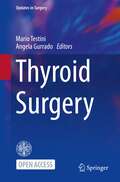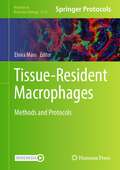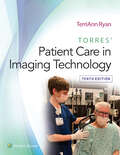- Table View
- List View
Techniques in Small Animal Wound Management
by Nicole J. BuoteTechniques in Small Animal Wound Management A thorough and practical guide to the surgical and non-surgical treatment of small animal wounds Techniques in Small Animal Wound Management focuses on surgical and non-surgical management techniques for the wide variety of wounds that clinicians in any stage of training or clinical practice treat in veterinary medicine. A comprehensive but accessible guide to wound management in small animal patients, this textbook covers all important wound management modalities and available products. This book includes detailed information on currently available products, including specific indications and instructions for use, and step-by-step descriptions of techniques used to treat wounds, making it an indispensable resource for small animal veterinary practitioners. Topics discussed range from the anatomy of wounded tissues, phases of healing, and classification of wounds to initial treatments, dressings, vacuum-assisted bandages, and surgical reconstructions. In Techniques in Small Animal Wound Management, readers will also find: Step-by-step instructions for using innovative wound management tools such as hyperbaric oxygen therapy, laser therapy, stem cell/platelet-derived treatments, leeches, and maggots. Detailed discussions of specific uses and indications for topicals, dressings, drains, bandages, and many other tools and techniques.Clinically oriented chapters offering tips for specific wounds such as burns, bite wounds, eyelid, lip, and ear wounds, and necrotizing fasciitis. Techniques in Small Animal Wound Management is an ideal practical reference for all veterinary students, small animal veterinary practitioners, and veterinary surgeons looking for a comprehensive guide to the wounds we treat.
Technology and Medicine: Shaping Modern Healthcare
by Bengt NielsenTaking a holistic approach, this book describes the developments in medicine and medical technology from ancient times to modern days. It is an exciting journey where readers will learn about the many great inventions by people that did not take the knowledge of their times as a fact. They challenged mysticism, beliefs, the religion, and the Church. They were true scientists long before we knew how to define what a scientist is. This book is, in a way, connecting the dots between the past and the future within healthcare. Features * Provides details on further developments that gave new and exceptional information for diagnostic or therapeutic purposes Gives the reader a new perspective and a common thread of life on medicine and MedTech as well as an improved understanding of how far we have come and how much there still is to work on before we fully understand the human body and its functionality Discusses and gives insight into ongoing research projects that could become clinically available in the future
Tell Me When It's Over: An Insider's Guide To Deciphering Covid Myths And Navigating Our Post-pandemic World
by Paul A. OffitFrom one of the world’s top virologists, the definitive guide to understanding—and navigating—COVID-19. Three years on, COVID is clearly here to stay. So what do we do now? Drawing on his expertise as one of the world’s top virologists, Dr. Paul Offit helps weary readers address that crucial question in this brief, definitive guide. As a member of the FDA Vaccine Advisory Committee and a former member of the Advisory Committee for Immunization Practices to the CDC, Offit has been in the room for the creation of policies that have affected hundreds of millions of people.In these pages, he marshals the power of hindsight to offer a fascinating frontline look at where we were, where we are, and where we’re heading in the now-permanent fight against the disease. Accompanied by a companion website populated with breaking news and relevant commentary, this book contains everything you need to know to navigate COVID going forward. Offit addresses fundamental issues like boosters, immunity induced by natural infection, and what it means to be fully vaccinated. He explores the dueling origin stories of the disease, tracing today’s strident anti-vax rhetoric to twelve online sources and tracking the fallout. He breaks down long COVID—what it is, and what the known treatments are. And he looks to the future, revealing whether we can make a better vaccine, whether it should be mandated, and providing a crucial list of fourteen takeaways to eradicate further spread. Filled with pragmatic analysis and sensible advice, TELL ME WHEN IT’S OVER is for anyone interested in finding new solutions to the new normal.
Tempted by the Single Dad Next Door
by Amy RuttanThe vet can&’t risk giving her heart away again. But her irresistible new colleague—and tenant next door!—is about to test her resolve… Dive in to Amy Ruttan&’s latest Harlequin Medical Romance! CAN THEIR CONNECTION OUTLAST THE SUMMER? Jilted vet tech Harley has sworn off relationships. But meeting her new tenant, vet Ryker, tempts her for the first time in years… The gorgeous single dad and his adorable son are only here temporarily, so Harley can&’t get attached. Yet as they work together, the strength of their chemistry is irresistible—and inconvenient since he lives next door! With nowhere to escape, giving in to their desires seems inevitable and dangerous to her heart…From Harlequin Medical: Life and love in the world of modern medicine.
Tempting the Off-Limits Nurse
by Tina BeckettCan she resist the surgeon she shouldn&’t want? Find out in Tina Beckett&’s latest heart-racing Harlequin Medical Romance! AN INCONVENIENT DESIRE… New nurse in town Eliana can&’t bear to be hurt by somebody again. So when sparks instantly fly with surgeon Jake, she&’s adamant about keeping their relationship purely professional. But after learning how Jake was betrayed by his ex-girlfriend, she knows he won&’t commit to a lasting connection either. Soon it&’s oh so tempting to give in to their mutual attraction…as long as forever remains firmly off-limits!From Harlequin Medical: Life and love in the world of modern medicine.
Teratogenicity Testing: Methods and Protocols (Methods in Molecular Biology #2753)
by Luís FélixThis fully updated volume collects laboratory techniques and tests to assess the risks to embryo-fetal development from drug exposure during early developmental stages. Beginning with a section detailing basic principles of teratogenicity, the book continues with application of in vitro models for teratogenic screening to predict toxicity in embryonic animals and humans, as well as a variety of well-established in vivo animal model tests, which offer solutions for evaluating the efficacy and the teratogenicity of compounds in preclinical trials before human safety testing. Written for the highly successful Methods in Molecular Biology series, chapters include introductions to their respective topics, lists of the necessary materials and reagents, step-by-step and readily reproducible laboratory protocols, and tips on troubleshooting and avoiding known pitfalls. Authoritative and practical, Teratogenicity Testing: Methods and Protocols, Second Edition serves as an ideal guide to tests that can be performed in cells, organs, tissues, and animal models for evaluating toxicity and/or safety of compounds in early developmental stages with the goal of estimating, preventing, or minimizing the teratogenic potential of drugs.
A Test of Morals: Surgical, Ethical, and Psychosocial Considerations in Human Head Transplantation
by L. Allen FurrWhile transplanting human heads is not a new concept, the idea has largely been relegated to religious lore or as a plot device in science fiction. But now, a surgical plan to perform the complex procedure exists, and though most physicians question head transplantation’s medical veracity, bioethicists have challenged the surgery on moral grounds. A Test of Morals compiles and examines the ethical questions that dog those who advocate for conducting this most radical of medical proposals in order to determine if society should move forward and allow head transplantation to occur. Current bioethical principles stand in opposition to head transplantation, causing a conflict of values rarely seen in medicine.
Textbook of Assisted Reproductive Techniques: Volume 2: Clinical Perspectives (Reproductive Medicine And Assisted Reproductive Techniques Ser.)
by David K. Gardner Ariel Weissman Colin M. Howles Zeev ShohamEstablished as the definitive reference for the IVF clinic, the sixth edition has been extensively revised, with the addition of several important new contributions on clinical topics, including The use of digitalization and precision medicine in the IVF clinic, The environment and reproduction, The use of gonadotropin-releasing hormone agonists and the efficiency of IVF, Controlled ovarian stimulation for freeze-all cycles, Immunology in ART, Home monitoring of ART cycles, Luteal-phase support in ART, The POSEIDON stratification of ‘low prognosis’ patients in ART, Controlled ovarian stimulation for low responder patients, Adjuvants for poor responders, Innovative therapies in diminished ovarian reserve and primary ovarian insufficiency patients, and Fertility options for transgender and nonbinary individuals. As previously, methods, protocols, and techniques of choice are presented by IVF pioneers and eminent international experts.
Textbook of Community Ophthalmology
by Praveen Vashist Noopur Gupta Suraj Singh Senjam Vivek GuptaThis book presents a comprehensive treatise on community ophthalmology principles and practices for countries with developing and emerging economies. It is replete with chapters on basic epidemiology, health economics, basic statistics and lays the foundation of the global eye health-care programs with skills for community-based epidemiological projects in eye care. With extensive experience in conducting various epidemiological surveys funded by the Ministry of Health, WHO, Indian Council of Medical Research, etc., the editors provide practical knowledge to ophthalmologists, public health specialists, physician-scientists, researchers, eye care program managers, optometrists, and academicians involved in community ophthalmology operational studies. Key Features:• Presents a single platform for knowing everything about community ophthalmology from statistics and epidemiology to financing in an easy and succinct manner.• Serves as a robust resource and an advanced teaching tool for medical professionals.• Includes well-illustrated, succinct chapters for better understanding of various aspects of public health in eye care.• Provides tips and tricks for dealing with both expected and unexpected situations while conducting epidemiological research and data collection in the field.
Textbook of Diabetes
by RICHARD I.G. HOLT Allan FlyvbjergTextbook of Diabetes Classic textbook providing diabetologists and endocrinologists with illustrated and clinically focused content on diabetes Now in its sixth edition, the Textbook of Diabetes has established itself as the modern, international guide to diabetes. Sensibly organized and easy to navigate, with exceptional illustrations, the textbook hosts an unrivalled blend of clinical and scientific content. Written by highly experienced editors and international contributors all of whom have provided insight on new developments in diabetes care. These include the most recent guidelines from the European Association for the Study of Diabetes (EASD), the American Diabetes Association (ADA), Diabetes UK, and the National Institute for Health and Care Excellence (NICE) and information on the latest treatment modalities used around the world. The textbook includes free access to the Wiley Digital Edition which provides easy-to-use searching across the book, the full reference list with web links, illustrations and photographs, and post-publication updates. Sample topics covered in Textbook of Diabetes include: Diabetes in its historical and social context, covering the history of diabetes, past classification and diagnosis of diabetes and the global burden of diabetes Normal physiology, covering glucose homeostasis, islet function and insulin secretion, and glucagon in islet and metabolic regulation Pathogenesis of diabetes, covering genetics of diabetes and obesity, autoimmune type 1 diabetes and other disorders with type 1 diabetes phenotype Other types of diabetes, covering endocrine disorders that cause diabetes, pancreatic diseases and diabetes and drug-induced diabetes Beautifully illustrated with a clinical focus, Textbook of Diabetes provides endocrinologists and diabetologists, both consultants/specialists and those in training, with a fresh and comprehensive clinical resource to consult time and time again. The text is also of value to specialist diabetes nurses and researchers in the field.
Textbook of Diagnostic and Therapeutic Procedures in Allergy
by Pudupakkam K. Vedanthan Harold S. Nelson Hugo P.S. Van Bever Mandakolathur R. MuraliThe uniqueness of this textbook lies in the fact that, it is the FIRST book in the field of allergy addressing in detail the various diagnostic and therapeutic procedures. The rationale behind presenting this book is to appraise the reader regarding the underlying principles of such procedures and to identify the limitations as well as usefulness in clinical practice. The chapters do include both traditional and modern methodologies representing the global nature of the specialty. Authors have been drawn across the globe to represent the variety of such procedures used in clinical medicine. This textbook will be appealing to medical students, physicians-in-training as well as consultants.
The Textbook of Health Psychology
by Meena HariharanThis book examines the concept of health psychology following its trajectory from ancient to contemporary times. It analyses the theories, practice and research in health psychology from both Indian and Western perspectives. The volume brings together knowledge diversified across various narrow subfields. It expounds upon physiological psychology; chronic illnesses associated with physiological systems; and biopsychosocial approaches to treatment and management with therapeutic interventions integrated throughout the book. It further discusses health promotive and health risk behaviour with reference to health policies and databases at national and global levels. This book will be beneficial to the students, researchers and teachers of psychology, applied psychology, public health, public policy, community health, and medical and paramedical studies. It will also be indispensable to the policy-makers and NGOs working in the field of public health.
Textbook of Traditional Chinese Medicine: Volume 2: Chinese Materia Medica, Prescription, Acupuncture and Moxibustion, Other Therapies and Common Diseases
by Yong Huang Lifang ZhuThis book covers all the contents from theoretical basis to clinical practice comprehensively, which are under the guideline of classic inheritance and the essence of TCM. TCM is a comprehensive discipline. In this book, philosophical foundation, physiology and pathology, etiology, differentiation and diagnostics, and health-preservation of TCM, Chinese materia medica and prescription, acupuncture and moxibustion, characteristic therapies, and common clinical disease are systematically arranged.Chapter 1 and Chapter 2 are about Chinese materia medica and prescription, presenting the tropism of natures, flavors and meridians, as well as commonly used prescription. Acupuncture and moxibustion therapy is the topic of Chapter 3, meridians and acupoints and acupuncture techniques are explained systematically and thoroughly. Chapter 4 is about some particular therapies such as massage, dietary therapy, qigong and Tai Chi. Chapter 5 mainly present clinical TCM therapies of common disease. And the last is appendix which provides supplementary materials as references.This book is a useful textbook for graduate and undergraduate students in medical schools, including MBBS (Bachelor of Medicine and Bachelor of Surgery) student.
Textbook of Traditional Chinese Medicine: Volume 1: Introduction, Examination, Etiologies and Pathogenesis and Differentiation of Syndromes
by Yong Huang Lifang ZhuThis book covers all the contents from theoretical basis to clinical practice comprehensively, which are under the guideline of classic inheritance and the essence of TCM. TCM is a comprehensive discipline. In this book, philosophical foundation, physiology and pathology, etiology, differentiation and diagnostics, and health-preservation of TCM, Chinese materia medica and prescription, acupuncture and moxibustion, characteristic therapies, and common clinical disease are systematically arranged.From Chapter 1-4, a clear picture of the philosophical foundation of TCM from yin-yang, five-element, qi, blood, body fluids and zang-fu viscera theory is presented. From Chapter 5-7 include etiology, pathogenesis, diagnostic and differentiation of syndromes. Chapter 8 is one of the most popular chapters with a topic of health-preservation. Chapter 9 mainly present clinical TCM therapies of common disease.This book is a useful textbook for graduate and undergraduate students inmedical schools, including MBBS (Bachelor of Medicine and Bachelor of Surgery) student.
Textbook of Von Willebrand Disease: Basic and Clinical Aspects
by Augusto B. Federici Erik E. Berntorp David Lillicrap Robert R. MontgomeryTEXTBOOK OF VON WILLEBRAND DISEASE Comprehensive resource summarizing recent research on von Willebrand disease, showing clinicians how to optimize management of patients with this disorder The newly revised and updated second edition of Textbook of von Willebrand Disease: Basic and Clinical Aspects, 2nd edition describes the important and complex role of von Willebrand factor (VWF) in hemostasis and thrombosis, covering not only the current understanding of its molecular biology, but also the association between genetic variants of VWF and different von Willebrand disease (VWD) phenotypes. The text also reviews the important area of the obstetric and gynecological manifestations of VWD, as well as how to manage patients with VWD for surgery. Many advances in agents are included in this updated edition, as well as the wide topics such as VWF in Angiogenesis, and VWF/ADAMTS13 as risk factors of thrombosis. Edited by a team of experts in VWD and an international team of contributors, Textbook of von Willebrand Disease covers sample topics such as: VWF structure and function, biosynthesis and organization of VWF, modulation of VWF by ADAMTS13 and assessment of VWF clearance Clinical, laboratory and molecular markers of different VWD types, from the mild forms of type 1 VWD and the moderate variants types 2A, 2B, 2M, 2N to the most severe type 3 VWD Pediatric aspects of VWD and of women with VWD Management of GI bleeds and appropriate therapies in surgery, and plasma-derived and recombinant VWF concentrates Acquired von Willebrand Syndrome, cardiovascular causes of AVWS, gastrointestinal bleeds in VWD and AVWS, and prophylaxis in von Willebrand disease Providing complete and accessible coverage of the subject, Textbook of von Willebrand Disease: Basic and Clinical Aspects, 2nd edition is a valuable resource for hematologists in practice and in training, along with specialists in thrombosis, hemostasis, and bleeding/clotting disorders.
Therapeutic Medicinal Plants in Traditional Persian Medicine (Exploring Medicinal Plants)
by Roja Rahimi Roodabeh BahramsoltaniTraditional Persian Medicine (TPM) is one of the oldest medical doctrines, globally known due to pioneering physicians and scientists. The greatest source of natural medicines in TPM originates from medicinal plants. Therapeutic Medicinal Plants in Traditional Persian Medicine provides a background on the history of TPM, as well as an introduction to 40 of the most popular medicinal plants used in TPM. It is a practical guide for readers interested in medicinal plants used in the prevention, management, and treatment of different diseases.Features: Includes both traditional therapeutic applications and modern evidence/ uses Makes a comparison between preclinical and clinical studies Provides information on major chemical constituents, therapeutic uses, adverse reactions, and safety for each plant species A volume in the “Exploring Medicinal Plants” series, this book is a valuable resource for researchers, students, academicians, and scientists dealing witth medicinal plants, as well as for those interested in the fields of pharmacognosy, naturopathy, phytotherapy, and traditional medicines.
Therapeutic Nutrition in Ayurveda
by Pankaj Wanjarkhedkar Yashwant V. PathakNutrition remains the key to the successful treatment of diseases, in addition to the various evolved medical treatments across the world. The treatment outcome improves to a better extent with a degree of nourishment of the patients. Therapeutic Nutrition in Ayurveda (TNA) categorizes diseases system-wise and discusses nutrition with references from Ayurveda classics as well as publications from indexed journals in today’s world. This book emerges as a pilot project to discuss the clinical experiences directly and the concept of nutravigilance by experienced authors of respective specialties like hepatology, neurology, dermatology, ophthalmology, oncology, cardiology, gynecology, and so on. It broadly discusses diet and nutrition based on 12 different groups of diet in Ayurveda. Nutrition has been widely discussed for every disease dynamically in Ayurveda, with details of exclusion and inclusion of foods over a stipulated period or entire duration of treatment. Key Features: Presents system-wise and disease-wise therapeutic nutrition Includes clinical experience of physicians on therapeutic nutrition Contains interdisciplinary discussion on therapeutic nutrition with an integrated approach The integration of traditional and conventional health systems, along with the multidisciplinary approach, is the emerging trend for inclusive health care in the coming decades. This book serves as a handy guide for health care professionals across the continents, providing interdisciplinary correlations on nutrition.
Therapeutic Proteins: Methods and Protocols (Methods in Molecular Biology #2720)
by Millicent O. Sullivan Bryce Chackerian Wilfred ChenThis volume covers the latest key aspects of therapeutic protein applications. Chapters in this book cover topics such as the discovery, production, and conjugation of protein-proteins with discussions on the direction of future development and advancements; ways to use these engineering proteins for therapeutic and vaccine applications; and the use of modified protein nanocarriers. Written in the highly successful Methods in Molecular Biology series format, chapters include introductions to their respective topics, lists of the necessary materials and reagents, step-by-step, readily reproducible laboratory protocols, and tips on troubleshooting and avoiding known pitfalls.Cutting-edge and practical, Therapeutic Proteins: Methods and Protocols is a valuable resource for any researcher who are interested in learning more about the field of therapeutic proteins.
Thermal Comfort Perception: A Questionnaire Approach Focusing on Children (Springerbriefs In Applied Sciences And Technology Ser.)
by Kristian FabbriThis book offers a comprehensive exploration of children's understanding and experiences of thermal comfort. The book provides a methodology for evaluating comfort that takes into account the unique perspectives of children. The first part of the book provides an overview of the history of thermal comfort, the human body and environmental parameters, and common thermal comfort indexes. It also offers guidelines for creating questionnaires that accurately assess children's perceptions of indoor thermal comfort. The book then delves into children's understanding of the concepts of comfort and energy, as well as the factors that influence their perception of these concepts. It addresses the psychological and pedagogical aspects of thermal comfort judgment, as well as the architectural and environmental characteristics that contribute to children's perceptions of comfort. First published as Indoor Thermal Comfort Perception, this updated edition also includes new sections on architecture and sensitivity, exploring the impact of classroom spaces on learning, and outdoor education and thermal comfort outdoors, based on qualitative research. These additions provide valuable insights for future studies on these topics. While physical parameter measurements and comfort indexes are useful in thermal comfort, the book emphasizes the importance of ergonomic assessments in the form of questionnaires, which offer unique insights into children's experiences. The book fills a critical gap in understanding children's perceptions of thermal comfort and is essential reading for HVAC engineers, architects, environmental psychologists, and researchers in the medical and cognitive fields.
Thinking About Medicine: An Introduction to the Philosophy of Healthcare
by David MisselbrookThis introduction to the philosophy of medicine surveys the landscape of western philosophy as it pertains to healthcare in an accessible way. Written by a doctor for doctors and other health professionals, framing the 'toolbox' of philosophy within the community of medicine, it encourages examination of the implicit assumptions made in the construction of medical knowledge and practice.Taking the reader step by step through the concepts that underpin modern philosophy, they will be challenged to reflect upon the premises within clinical practice which might benefit from scrutiny and challenge, including the nature of scientific knowledge, the limits of our biomedical model, the cultural and relational context, and the failure to recognise or manage adequately the fact/value distinction in medicine and healthcare.The book is an ideal textbook for students of medicine and medical philosophy and will also be of interest to bioethicists, medical sociologists, clinical commissioners and to practicing clinicians in medicine and the allied health professions seeking to improve their understanding of philosophy and ethics and sharpen their critical thinking skills.
Thinking about Science: Good Science, Bad Science, and How to Make It Better (ASM Books)
by Ferric C. Fang Arturo CasadevallThinking about Science: Good Science, Bad Science, and How to Make It Better A riveting exploration of the world of science, diving headfirst into its triumphs and tribulations. Penned by seasoned microbiologists Ferric C. Fang and Arturo Casadevall, this book offers a comprehensive analysis of the scientific enterprise through various lenses, including historical, philosophical, and personal. From their unique vantage points as researchers, clinicians, and educators, Fang and Casadevall dissect the intricate mechanisms of science, shedding light on its strengths and weaknesses. Through engaging historical anecdotes, personal narratives, and insightful academic studies, they present a candid evaluation of science�s performance, including a thought-provoking examination of its role during the COVID-19 pandemic. A must-read for anyone curious about the present predicaments and future potential of science, Thinking about Science: Good Science, Bad Science, and How to Make It Better is more than just a book; it�s a roadmap to understanding and improving the scientific endeavor for the benefit of society at large. �The authors have given us a thoughtful description of science and the joy of discovery, an unflinching diagnosis of where improvements are needed, and recommendations for remedies well worth considering. Scientists, science and society would benefit if this book were read by both future and established scientists, as well as the administrators, policymakers, and regulators who are in a position to help us do better.� �Michael Kalichman, UC San Diego �With a deep understanding of the profound impact of science on society, the authors provide thought-provoking perspectives on changes in the scientific enterprise that will support sustainable, equitable practices, and engender public trust. An engaging read for everyone with an interest in science or science policy. � �Stanley Maloy, San Diego State University
The Third Net: The Hidden System of Migrant Health Care (Health, Society, and Inequality #5)
by Lisa Sun-Hee Park Erin Hoekstra Anthony M. JimenezReveals the presence of an informal system of valuable support and care for marginalized migrantsThe United States’ health care system not only consists of a formal safety net, but also an informal and disjointed network of organizations that offer basic care to millions of migrants. This “Third Net” provides free or low-cost health care for the undocumented, low-income, and uninsured migrants who are excluded from the formal system. This groundbreaking study sheds light on the existence of the Third Net and its implications for the overall inequalities in the US health care system.The Third Net is made up of diverse providers with varying levels of service, organizational culture, and mission. These providers operate in unconventional settings, such as mobile clinics on wheels; pop-up clinics in repurposed spaces; and unlicensed, makeshift clinics run by health activists. Despite their unassuming appearances, these clinics are vital resources for marginalized populations that often go unnoticed by the general public, revealing the shortcomings of our formal health care system.By examining these alternative health care spaces, the authors expose the inequities entrenched in the broader health care system and urge a reevaluation of it entirely in order to address these injustices.
Thyroid Surgery (Updates in Surgery)
by Mario Testini Angela GurradoThis open access book on thyroid surgery has been authored by an international team of contributors who present a comprehensive understanding of both benign and malignant thyroid disorders. It also outlines an interdisciplinary approach to their surgical management that reflects the latest changes in surgical techniques. The book reviews the most up-to-date literature available on thyroid surgery and presents it in a concise manner for use in clinical practice. For each thyroid disorder, the book covers etiology, clinical manifestations, diagnostic and localization procedures, as well as surgical and non-surgical treatment options. The operating techniques and postoperative management are explained in detail, while the benefits, risks, controversial issues, and cost-effectiveness of each approach are reviewed. To aid in the understanding of complex information, the book features drawings and photographs. Written in an easy-to-understand style, the book includes tables and diagrams that highlight best practices and current guidelines, as well as self-assessment material at the end of each section. It serves as an ideal resource for all levels of surgical experience, from a practical reference for endocrine surgeons to a perfect companion for students and residents.
Tissue-Resident Macrophages: Methods and Protocols (Methods in Molecular Biology #2713)
by Elvira MassThis detailed book delves into the diverse techniques and applications to target, isolate, image, phenotype, and analyze tissue-resident and monocyte-derived macrophages. The contents aim to describe the current knowledge about macrophage development and function which forces the scientific field to move beyond the previously described M1/M2 macrophage paradigm to be able to dissect macrophage functions within their specific niches during health and disease. Written for the highly successful Methods in Molecular Biology series, chapters include introductions to their respective topics, lists of the necessary materials and reagents, step-by-step and readily reproducible laboratory protocols, and tips on troubleshooting and avoiding known pitfalls. Thorough and practical, Tissue-Resident Macrophages: Methods and Protocols provides scientists entering the macrophage field with information and tools that allow them to dive into the state-of-the-art methodology used in this vital field.
Torres' Patient Care in Imaging Technology
by TerriAnn RyanNow fully aligned with the latest ARRT and ASRT standards,Torres’ Patient Care in Imaging Technology, 10th Edition, by TerriAnn Ryan, helps students develop the knowledge and skills they need to become safe, perceptive, and efficient radiologic technologists. This student-focused text offers a strong illustration program and a logical organization that emphasizes the connections between classroom learning and clinical practice. Designed to keep readers informed and up to date, it covers current trends and advances in the field and offers an unparalleled array of online teaching and learning resources.
